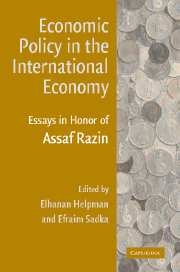Book contents
- Frontmatter
- Contents
- List of Contributors
- Preface
- Introduction
- PART ONE FINANCIAL ISSUES IN OPEN ECONOMIES: THEORY
- 1 Crises: The Next Generation?
- 2 Solutions (?) to the “Devaluation Bias”: Some Preventive Measures to Defend Fixed Exchange Rates against Self-Fulfilling Attacks
- 3 Growth-Enhancing Effects of Bailout Guarantees
- 4 Risk and Exchange Rates
- PART TWO FINANCIAL ISSUES IN OPEN ECONOMIES: EMPIRICS
- PART THREE ECONOMIC GROWTH: THEORY AND EMPIRICS
- PART FOUR PUBLIC ECONOMICS
- PART FIVE POLITICAL ECONOMY
- Author Index
- Subject Index
1 - Crises: The Next Generation?
Published online by Cambridge University Press: 03 November 2009
- Frontmatter
- Contents
- List of Contributors
- Preface
- Introduction
- PART ONE FINANCIAL ISSUES IN OPEN ECONOMIES: THEORY
- 1 Crises: The Next Generation?
- 2 Solutions (?) to the “Devaluation Bias”: Some Preventive Measures to Defend Fixed Exchange Rates against Self-Fulfilling Attacks
- 3 Growth-Enhancing Effects of Bailout Guarantees
- 4 Risk and Exchange Rates
- PART TWO FINANCIAL ISSUES IN OPEN ECONOMIES: EMPIRICS
- PART THREE ECONOMIC GROWTH: THEORY AND EMPIRICS
- PART FOUR PUBLIC ECONOMICS
- PART FIVE POLITICAL ECONOMY
- Author Index
- Subject Index
Summary
When I first began working on the theory of currency crises in 1977, I imagined that it was a subject mainly of historical interest. The motivating events were the speculative attacks that brought down the Bretton Woods system in 1971 and the Smithsonian system in 1973. Given the end of fixed rates for major economies, it seemed unlikely that such events would recur.
Of course, that's not how it turned out. The fixed rates of Latin American nations offered a target for large speculative attacks in the runup to the debt crisis of the 1980s; the fixed rates of the European Monetary System offered targets for a wave of speculative attacks in 1992–93; and the more or less fixed rates of Asian and other developing nations offered targets for yet another round of attacks in 1997–98.
Yet while the continuing relevance of the general idea of speculative attacks has justified the original theoretical interest in the subject, the actual models have not fared as well. When Eichengreen, Rose, and Wyplosz (1995) introduced the terminology of “first-generation” and “second-generation” crisis models, they also highlighted the somewhat disheartening fact that each wave of crises seems to elicit a new style of model, one that makes sense of the crisis after the fact. And sure enough, the Asian crisis led to a proliferation of “third-generation” models, quite different from either the first or the second generation.
- Type
- Chapter
- Information
- Economic Policy in the International EconomyEssays in Honor of Assaf Razin, pp. 15 - 32Publisher: Cambridge University PressPrint publication year: 2003
- 14
- Cited by

